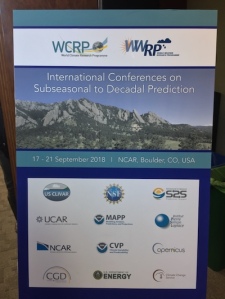Last week NCAR in Boulder (Colorado) hosted the second edition of the International Conference on Subseasonal to Decadal prediction. It covered the climate prediction from a few weeks up to a few years and hosted with around 350 scientists a good representation of the community in this field. During most of the days the conferences was split into a subseasonal to seasonal (S2S) and a seasonal to decadal (S2D) session.
I personally visited only the S2D part, as my current work focuses on this topic. The first day looked into the mechanisms of predictability and the typical candidates, like ocean, soil moisture and stratosphere, were discussed. The second day shifted then more to the modelling of these phenomena. The weather services presented their new prediction systems and new approaches to modelling were discussed. As a third topic covered the handling of the predictions. It looked at calibration and other technique to make the prediction really useful. This lead to the fourth topic, which discussed the decision-making process basing on the prediction. Here, the applications were the main focus points and many different phenomena and their predictability were shown. Topic number five looked at the statistical verification. It presented new approaches to access the skill of the models. The final session of the S2D session looked at the frontiers of earth system prediction and therein especially at the handling of carbon within the models. Afterwards in a combined session of both parts many different aspects on the future of research in this field were brought up. Among others the topics of temporal dependence of forecast skill and the so-called ‘signal to noise paradox’ lead to a lively discussion.
My personal contributions were threefold. I showed on a poster in the first session how the Summer NAO can be predicted using ensemble sub-sampling. In the second session I presented a poster on the view that sub-sampling can be viewed as a post processing procedure and can so explain why it works. The talk in the fifth session then covered the 2D categorical EMD score.
All in all it was a great conference, with many interesting discussions and a great overview over this interesting field. Certainly many impulses will come from this and will give not only my own research a new push.

